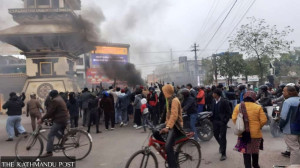National
Students from rural Kalikot leave villages for tuition as SEE preparations begin
Lack of subject teachers, cold weather, and poor infrastructure force the students to migrate for exam preparation.
Krishna Prasad Gautam & Tularam Pandey
Students from Kalikot’s Tilagufa Municipality are leaving their villages months ahead of the Secondary Education Examination (SEE) to attend tuition classes in Surkhet. Despite schools being open until mid-December, most Class 10 students had already moved to Surkhet for tuition by the Dashain-Tihar holidays.
Chakra Bahadur Shahi, headmaster of Kalika Secondary School, Tilagufa, said that out of 33 students enrolled in Class 10, none remain in the village.
“After the Dashain and Tihar holidays, many students had already left, and with the winter vacation nearing its end, no one has informed us about returning,” Shahi said. “Attending tuition in Surkhet has become a trend. They will likely return only in February or March to sit for the SEE exams.”
Last year, only one of the 34 SEE candidates from the school passed the regular exams. The school suffers from a severe lack of secondary-level teachers, with just two relief quota teachers and one municipal grant teacher handling classes.
Aditya Shahi, a Class 10 student at Shivalaya Secondary School, left for Surkhet earlier in December to attend tuition classes. “Barely 50 percent of our course has been completed, and frequent holidays have disrupted our studies,” he explained. “Tuition in Surkhet seemed the only option to prepare adequately for the exams.”
Empty classrooms, packed tuition centres
Surkhet’s tuition centres, which charge Rs2,000 per subject per month, are currently overcrowded. Many students from Kalikot’s schools have opted for this expensive preparation. Bimal Dhakal, another Class 10 student, reported that over a dozen of his classmates have joined the same tuition institute as him.
Tilak Prasad Neupane, the headmaster of Mahadev Secondary School, said that 60-80 percent of the Class 10 curriculum has been completed. However, he emphasised that if extra classes were conducted locally, parents would save money, and students would benefit academically. “It’s not just up to the schools to stop this migration,” he added.
Financial and social struggles
The migration poses a significant financial burden on families. Shivalaya Secondary School management committee chair Birkha Sunar estimated that each student spends Rs10,000-12,000 per month for tuition. “Most parents in this area are impoverished,” he said. “They take loans to send their children to Surkhet.”
Santosh Shahi, a parent, noted that the trend is not new. “Both my sons went to Surkhet for tuition, costing Rs50,000-60,000 for three to four months,” he said. “This happens every year because courses are not completed at schools.”
Students who cannot afford to move to Surkhet attend tuition classes in the district headquarters, Manma, where fees are slightly lower.
Local authorities plan action
Mayor of Tilagufa Municipality Shankar Prasad Upadhyaya acknowledged that the issue has persisted for years. “We are preparing a municipal-level plan to address the problem,” he said. The plan includes ensuring timely course completion, conducting regular classes, and offering extra classes within the schools.
This year, nearly 4,000 students from Kalikot’s 64 secondary schools are preparing to sit for the SEE exams, according to Education Development and Coordination Unit head Lal Prasad Pokharel.




 6°C Kathmandu
6°C Kathmandu








%20(1).jpg&w=300&height=200)







